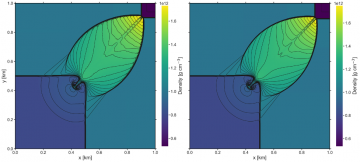
Achievement
- High-order Runge–Kutta Discontinuous Galerkin (RKDG) methods for astrophysical hydrodynamics have been extended to accommodate a tabulated nuclear equation of state (EoS) — necessary for multiphysics simulations of core-collapse supernovae (CCSNe). Extensions of the RKDG method include (i) a characteristic-based limiting strategy for tabulated nuclear EoSs to reduce non-physical oscillations in the vicinity of shocks, and (ii) a bound-enforcing limiter to maintain physically admissible solutions.
- The algorithms have been incorporated into the toolkit for high-order neutrino-radiation hydrodynamics (thornado).
- The extended limiters improve the fidelity and robustness of simulations with shocks.
Significance and Impact
Massive stars end their lives as spectacular explosions known as core-collapse supernovae (CCSNe). These explosions are at the heart of some of the most important questions in astrophysics. They are the primary catalysts of galactic chemical evolution, producing and dispersing many of the elements heavier than hydrogen and helium, and provide feedback into the interstellar medium. They may even be a source of the lighter r-process elements. Their cores are the foundries for compact objects including those recently detected by the Advanced LIGO and Virgo gravitational wave observatories. Through their observables and the compact objects left behind, we may begin to probe the nature of nuclear matter. Insight into these questions relies on modeling and simulation with advanced simulation tools and massive computational resources, and hydrodynamics, along with gravity and neutrino transport, plays a key role in CCSN dynamics. RKDG methods are widely used in science and engineering applications, and are gaining popularity in the computational astrophysics community, but have so far not been applied to multiphysics CCSN simulations. The Introduction of a nuclear matter equation of state (EoS) is required for realistic models, but also complicates the numerical procedure. For instance, when solving the conservation equations for mass, momentum, and energy, the implementation of a nuclear EoS requires an additional conservation law for electrons. Moreover, the EoS is not in closed analytic form, and on-the-fly numerical evaluation of a realistic EoS is computationally expensive. Thus, for computational expediency, EoSs are provided in tabulated form, and interpolations are used to access quantities away from table vertices. The research extends RKDG methods for shock hydrodynamics to the case with a tabulated nuclear EoS. These advancements, and their implementation into thornado, clear the way for future neutrino radiation-hydrodynamics simulations with RKDG methods.
Research Details
The extension of RKDG methods to shock hydrodynamics with a tabulated nuclear EoS is nontrivial. First, since slope limiting techniques — needed to stabilize the numerical method around shocks — are most effective when applied to so-called characteristic fields. To this end, we have provided the characteristic decomposition of the flux Jacobian matrices for a nuclear EoS and demonstrated how the extended limiter improves the fidelity of simulations with shocks. Second, since the domain of validity of the nuclear EoS is more complex than the case for an ideal EoS, we have extended a bound-enforcing limiter to maintain physically admissible states. Specifically, the bound-enforcing limiter prevents the internal energy from dropping below the lower physical limit. Simulations of shock formation associated with the collapse of a stellar core demonstrates that the bound-enforcing limiter maintains physically valid solutions.
Citation and DOI
Pochik, D., Barker, B.L., Endeve, E., Buffaloe, J., Dunham, S.J., Roberts, N., Mezzacappa, A., 2020, “thornado-hydro: a discontinuous Galerkin method for supernova hydrodynamics with nuclear equations of state”, submitted to the Astrophysical Journal Supplement Series
Overview
The research developed algorithms for non-relativistic hydrodynamics in the toolkit for high-order neutrino radiation hydrodynamics (thornado), which is being developed for multiphysics simulations of core-collapse supernovae (CCSNe) and related problems with Runge-Kutta discontinuous Galerkin (RKDG) methods. We have extended limiters — a slope limiter to prevent non-physical oscillations and a bound-enforcing limiter to prevent non-physical states — from the standard RKDG framework to be able to accommodate a tabulated nuclear equation of state (EoS). To demonstrate the efficacy of the algorithms with a nuclear EoS, numerical results from basic test problems in idealized settings in one and two spatial dimensions, employing Cartesian, spherical-polar, and cylindrical coordinates, are presented. Then, the RKDG method is applied to the problem of adiabatic collapse, shock formation, and shock propagation in spherical symmetry, initiated with a 15 solar mass supernova progenitor. We find that the extended limiters improve the fidelity and robustness of the RKDG method in idealized settings. The bound-enforcing limiter improves robustness of the RKDG method in the adiabatic collapse application, while we find that slope limiting in characteristic fields is vulnerable to structures in the EoS — more specifically, in the phase transition from nuclei and nucleons to bulk nuclear matter. The success of these applications marks an important step toward applying RKDG methods to more realistic CCSN simulations with thornado in the future.
Last Updated: January 19, 2021 - 1:04 pm